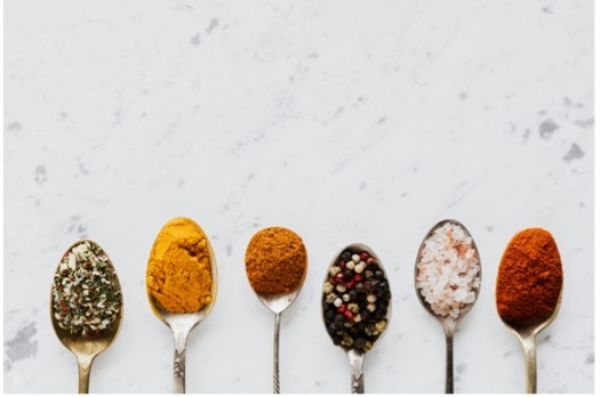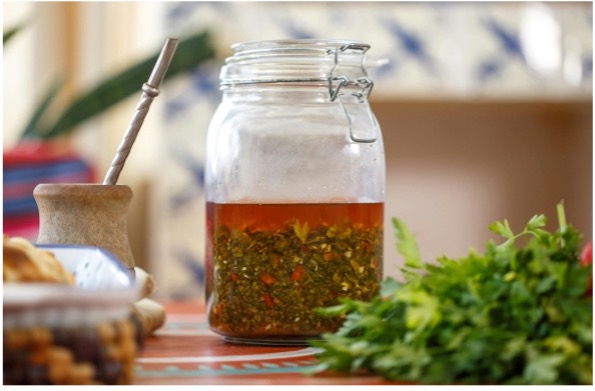
Guide To Seasonings, Dressings, And Marinades
August 26, 2025 - Mallori Adragna
Introduction
Cooking can be a hobby, bring people together, can act as a hobby, or an outlet to express yourself and your culture. A critical component of self-expression through cooking is flavor, by choosing herbs, spices, and pairings that represent your preferences and background. Seasonings, dressings, and marinades are three techniques for flavoring food that allow your creativity to shine. Here is an overview of each technique and how they are used differently:
- Seasonings: dry blend applied during or after cooking
- Dressings: primarily used on salads or cold dishes to add flavor and moisture
- Marinades: liquid mixture used to flavor and tenderize before cooking
This article will give you a basic guide to seasonings, dressings, and marinades with descriptions, basic formulas, and examples. In following this guide, you will be able to flavor your food like a professional while adding your own personal touch.
Guide to Seasonings
Seasoning refers to a dry blend of herbs, spices, and salt added to food to enhance the flavor. It’s best practice to season at the beginning and end of cooking. When cooking, you can utilize simple seasonings like onion powder, paprika, salt and pepper or get more complex utilizing dried herbs along with spices. Herbs are typically from the leaves of a plant whereas spices are from the other parts like the stems; however, herbs do fall under the broader category of spices. For more details on the classifications of herbs and spices check out the resource here.
Formula
- Herbs and/or spices + salt + pepper
Examples:
- Garam Masala – cumin, coriander, cardamom, cinnamon, cloves, nutmeg, & black pepper
- Italian Seasoning – basil, oregano, rosemary, marjoram, thyme, & red pepper flakes
- Cajun Seasoning – paprika, garlic powder, cayenne pepper, black pepper, & onion powder
- Za-‘atar Seasoning – oregano, marjoram, thyme, cumin, coriander, sesame seeds, sumac & salt
- Taco Seasoning – Chili powder, cumin, paprika, garlic powder, onion powder, dried oregano, salt & black pepper

Guide to Dressings
Dressings include a liquid or semi-liquid mixture with flavor enhancers that act as dips or are added to foods like salads. To prevent separation, some dressings need an emulsifier like mustard, honey, or egg yolk. The important thing to remember with dressings are ratios. The proper ratio of oil, acid, and emulsifier determines if the dressing separates or not. A baseline ratio is three parts of oil to one part of an acid, but the more emulsifier you use, the more acid you can add.
Basic Formula
- Vinaigrette = oil + acid + emulsifier + salt + pepper
- Creamy dressing = fat + acid + salt + pepper
Examples:
- Ranch (creamy) – sour cream, mayonnaise, buttermilk, herbs, garlic, & lemon juice
- Tzatziki (creamy) – Greek yogurt, olive oil, vinegar, cucumber, dill, & garlic
- Balsamic (vinaigrette) – olive oil, balsamic vinegar, Dijon mustard, sweetener (like honey), garlic, salt & pepper
- Pesto – olive oil, lemon juice, pine nuts, parmesan, garlic, basil, parsley, salt & pepper
- Chermoula – olive oil, coriander, parsley, garlic, cumin, paprika, chili peppers, salt
Guide to Marinades
Marinades are mixtures containing oil, seasonings, and acidic ingredients to intensify flavors and tenderize meats. It’s important to keep in mind, different types of proteins (meat, poultry, seafood) have ideal times they can be marinated for. A website here has a table with suggested times to marinate for your reference. Remember, marinades that are used on raw meat, poultry and seafood, must be thrown away after using to prevent foodborne illness. When you are in a pinch, store bought dressings can act as a marinade as they follow a similar formula!
Formula
- Acid + oil + herbs and/or spices + salt
Examples:
- Acids: Yogurt in Indian cuisines, Soy Sauce in Korean or Asian marinades, lemon juice in Mediterranean marinades.
- Oils: Olive oil is a great option for any marinade, but you can also use sesame oil, coconut oil, vegetable oil or oil blends.
- Flavor Enhancers: For an Asian inspired marinade use flavors like ginger, lemongrass, and tamarind. Achiote, cilantro, lime, an chilies are perfect herbs and spices for a Mexican marinade. To complement the yogurt in an Indian marinade, use spices kike cardamom, ginger, turmeric, and chilies.
- Chermoula can be both a dressing (above) or a marinade
- For more culture specific marinade ideas, click here.
Conclusion
Seasonings, dressings and marinades differ in their applications, purpose, and ability to impart flavor, but they all have a purpose in cooking. Now that you know the basics of seasonings, dressings and marinades you can start creating your own based on your preferences!
Articles For Your Reference:
- Seasonings
- Dressings
- Marinades



 Print
Print Email
Email





